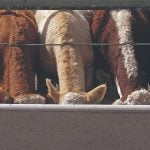For the week ending November 16, Western Canadian calves over 650 pounds were up $3-$6/cwt compared to seven days earlier. Calves under 650 pounds traded $4/cwt to as much as $10/cwt higher.
Despite adverse weather in certain regions, the market experienced no slippage. The weaker Canadian dollar enhanced fed cattle prices in the deferred positions which may have contributed to the stronger tone. Buyers once again had a full deck of orders at higher prices with some feedlots needing significant numbers before year-end.
The USDA is expecting 2025 third quarter beef production to finish near 6.5 million pounds, down nearly 300 million pounds from the third quarter of 2024. There’s a very bullish sentiment brewing for the third and fourth quarters of 2025. This is making the lighter calves extremely precious.
Read Also

U.S. livestock: Feeder cattle hit contract highs on tight supply
Chicago | Reuters – All Chicago Mercantile Exchange feeder cattle futures and most live cattle futures hit contract highs on…
West of Edmonton, Simmental Charolais cross yearling heifers weighing 1,077 pounds off grass and hay diet traded for $289 and red mixed heifers off grass weighing 936 pounds supposedly sold for $306. South of Edmonton, a small package of 900 pounds mixed steers off grass reportedly sold for $322.
Northwest of Winnipeg, Charolais-based short-weaned steer calves weighing 847 pounds sold for $350. In southwest Manitoba, a smaller group of mixed heifers weighing 841 pounds notched the chart at $322. Near Red Deer, larger frame red steer calves off cows and grass averaging just over 800 pounds dropped the gavel at $369. In the same region, black Limousin based heifers averaging 725 pounds settled at $341.
At the Lloydminster sale, tan heifers weighing 700 pounds supposedly reached up to $349 and tan steers around 706 pounds were last bid at $387. In southwest Manitoba, Angus based steers averaging 640 pounds were on the market report at $420 and similar quality heifers measured at 635 pounds were clocked at $373.
North of Saskatoon, British-blended steers averaging 550 pounds sold for $454 and similar quality 500 pound steers topped out at $495. The Killarney market report had black steers averaging 524 pounds valued at $489 and similar quality heifers measured at 515 pounds trading for $399. In central Saskatchewan, Charolais based steers weighing 400 pounds were last bid at 585 and in central Alberta, Limousin blended heifers scaled at 390 pounds were quoted at $491.
In southern Alberta, fed cattle traded on a live basis in the range of $253-$255 fob feedlot. Breakeven pen closeouts are around $255. Prices on the rail delivered were quoted from $405-$419. Feedlots are current production margins are expected to remain around breakeven over the next month.
— Jerry Klassen is president and founder of Resilient Capital, specializing in proprietary commodity futures trading and market analysis. Jerry consults with feedlots on risk management and writes a weekly cattle market commentary. He can be reached at 204-504-8339 or via his website at ResilCapital.com.















